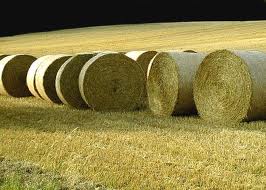Hay Storage Considerations: Don’t Waste It!

Large bales are a convenient form of hay for one-person operations. These bales can be moved, stored and fed relatively easily with the right equipment. Hay loss can occur when baling, moving and feeding so some is unavoidable. The biggest loss – both dry matter and digestibility – occurs with outdoor storage. Dry matter loss can reach 50% depending on the beginning quality, storage conditions and length of storage. It is not always realistic or practical to build a barn to store hay. Here are some tips to minimize waste from outdoor storage.
Hay that has been tightly baled tends to shed water better. The outer layer forms a thatch to reduce water infiltration. Placing the bales lined up tightly together end to end helps with shedding precipitation. Pick a site that has good ventilation, away from hedgerows and wooded areas. This gives bales a better chance to dry out from air movement. Row spacing of at least 3 feet for good air flow and sunlight penetration is an excellent strategy. It’s also a good idea to keep vegetation mowed between rows.
Ideally, bales should be stored off the ground. Hay stored directly on the ground may lose up to 12 inches on the bottom of the bales due to wicking action. Find some waste material such as old fence posts, pallets or tires and place the bales on top. Gravel or stone may work too. Research was conducted by University of Tennessee comparing different methods of storing large round bales of grass hay. The hay was cut and baled in June. The bales were weighed at the time of harvest and storage. Then they were weighed again the following January at the time of winter feeding. Table 1 lists the type of storage and the resulting percentage hay loss.
Note the difference between storage in the barn and on tires and covered. Some small changes can make a big difference! Plastic tarps can be relatively inexpensive when the savings from reducing loss is calculated.
For more information on hay production, see ‘Hay Production Resources for NYS and Similar Climates’ available online.


